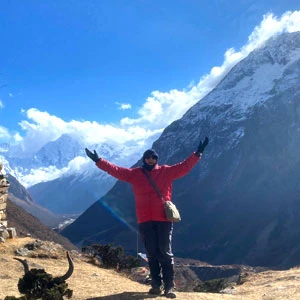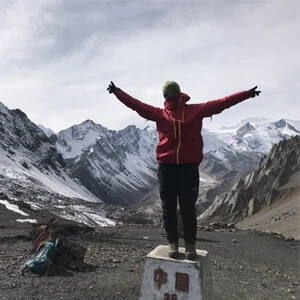Upper Mustang Trek
The forbidden Buddhist kingdom of Lo, known in modern times as Mustang, remains one of the last true bulwarks of traditional Tibetan culture, hidden away in its secluded and highly protected barriers on Nepal's northern border. Formerly an outlying province of Tibet itself, Mustang's entire culture, language, and philosophical outlook on life revolve around the ancient ties to its near-mythical neighbor — even its geography reflects that of the Tibetan steppe which both share.
Caught in the formidable rain shadow cast by the Himalayan ranges, chiefly the Annapurna massif and Dhaulagiri, the Mustang region is an arid land of stark earthen colors and rugged canyons, with distant snow-capped mountains offering a tantalizing promise of life-giving waters that rarely touch the parched high-altitude plateau other than through the precious resource of the Kali Gandaki River. Other than basic subsistence agriculture, the Lopa inhabitants of the valley have traditionally herded yak and in times gone by prospered through trade with Tibet. Despite the harsh conditions wildlife abounds in the region, with animals such as musk deer, Tibetan wild ass, Tibetan gazelle, and even the legendary snow leopard thriving in the area.
Unlike the majority of treks in Nepal the journey into Upper Mustang Region offers a rare glimpse into a regional capital of historic and cultural interest that's as magnificent in its isolation as it is appealing to the camera lens. Lo Manthang was long the royal stronghold, and while the monarchy has been abolished the sturdy palace still remains behind the town's medieval walls, though much of it sustained considerable damage during the 2015 earthquake. To enter the gates and narrow winding streets is to feel as if one is stepping through a window in time to an era from centuries ago like some latter-day Marco Polo stumbling in through the mountain wilderness to find a remote outpost of humanity defying description or belief. Housed within the tall whitewashed walls are four monasteries of significance, the Gompas of Jampa Lhakchang, Thubchen, Chodey, and Choprang. Nearby Chhoser is not only home to another notable monastery but has seen significant discoveries of major archeological importance made in the Sky Caves carved into the cliffs above the village for burial purposes. The cave paintings, illuminated Buddhist manuscripts, sculptures and numerous artifacts being found are slowly bringing international attention to the region.
The journey to Lo Manthang typically starts with a flight from Pokhara to Jomsom, the popular trekking hub that's both a start and end point for several treks in the area and leads from there northward through the stunning Kali Gandaki Gorge, the world's deepest. Kagbeni serves as the checkpoint for entry into the heavily restricted Upper Mustang Trek(where you must have a licensed guide and Special Trekking Permits), and over the ensuing days, numerous passes lead through the arid landscape and its vividly striated bands of color toward Lo Manthang, where we pause for a day to take in all that the centuries-old outpost of Tibetan civilization has to offer. The trek back to Dhakmar pauses at the 8th-century monastery of Lo Gekar, then continues across the windswept plateau past the foothills of Annapurna and Dhaulagiri to the sacred pilgrimage destination of Muktinath. From there the trail heads back to Jomsom, a well-earned rest, and the return flight to Pokhara.
Mustang Restricted Area Adventure not only served as an extraordinary adventure to a remote part of Nepal that's scenically distinct from the rest of the country but also as a window to a highly preserved culture that seems a throwback to long-distant days in Tibet — at times it would hardly surprise to turn a corner and see the Potola itself perched high on a nearby hilltop. It's ready and waiting for you to explore, and the staff of Nepal Trekking Experts is on hand to help organize your trip to this fascinating region.
Alternatively, you may also like other less visited trekking routes, in Nepal, such as the Nar Phu Valley Trek, the Manaslu Circuit Trek, the Kanchenjunga Circuit Trek and more.
Upper Mustang Cultural Trek
The Upper Mustang Cultural Trek is moderately challenging, requiring a good level of physical fitness and mental preparation. During this journey, you will trek past remote and rugged terrain with steep ascents, rocky paths, and high-altitude sections. While the trek only takes you to a maximum elevation of 3,800 meters (12,467 feet) at Lo Manthang, you may face altitude-related problems. Despite the challenges, the trail is well-defined, making navigation straightforward, especially with an experienced guide.
Overall, the trek takes place in a dry and arid landscape with a lack of vegetation and exposure to strong winds, particularly in the Kali Gandaki Gorge. Additionally, the climate in Upper Mustang is generally dry, with intense sunlight during the day and cold temperatures at night. All these factors combined with limited amenities along the way add up to your difficulty.
Best Time To Trek To Lo Manthang
The best time for the Trek to Lo Manthang is during the Spring (March to May) and Autumn (September to November) seasons, when the weather is most favorable. In Spring, the temperatures are mild, and the region’s sparse vegetation comes alive with occasional blooms, adding subtle color to the desert-like terrain. Autumn is equally rewarding, with crisp air and excellent visibility, making it ideal for photography and enjoying the spectacular scenery.
Furthermore, unlike many other treks in Nepal, Upper Mustang is located in the Trans-Himalayan region, which falls under a rain-shadow area. This unique geography means the trek is also possible during the Monsoon (June to August). While other regions experience heavy rainfall, Upper Mustang remains relatively dry, with only occasional light showers. However, Spring and Autumn are still preferred for their more comfortable temperatures and consistent weather patterns.
Lastly, Winter (December to February) is the least favorable time for this trek due to extreme cold, especially in the higher altitudes. Many tea houses and local facilities may also close during this season.
High-Altitude Mustang Trek Permits
Trekking in the Upper Mustang region requires two key permits: the Restricted Area Permit (RAP) and the Annapurna Conservation Area Project (ACAP) Permit.
- Restricted Area Permit (RAP): $500 per person for the first 10 days, with an additional $50 per person per day for any extra days beyond that period.
- Annapurna Conservation Area Project (ACAP) Permit: $20 per person to trek through the Annapurna Conservation Area.
Both permits can be obtained in Kathmandu or Pokhara. The Restricted Area Permit is issued by the Department of Immigration, while the ACAP Permit is available at the offices of the Annapurna Conservation Area Project in either city. To secure the permits, you will need your passport, two passport-sized photos, and details of your trekking itinerary. Additionally, the Restricted Area Permit requires trekkers to travel with a registered guide and in groups of at least two people, as solo trekking is not allowed in Upper Mustang.
Booking And Payment With Nepal Trekking Experts
To book your trek with us, you have to send a deposit of 10% of the total cost of the trek. Please also forward a copy of your passport, a passport-sized photo, and full flight details if and when available. For your convenience, you may also forward the deposit to us online through our website. It is completely safe, and as soon as you make it, you will get an automatic receipt in your inbox. The rest of the payment can be paid upon arrival.
If you have any questions, do not hesitate to contact us anytime. We are always ready to assist.
















